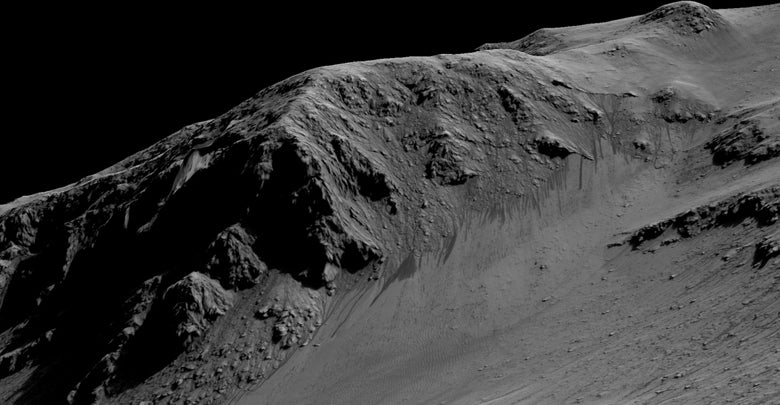|
September 29, 2015
The discovery of liquid water on Mars increases chances of life on the planet, Stanford scientists say
New results indicate that liquid water flows seasonally on Mars, most likely fed by subsurface features, where the briny water might be more hospitable to life. By Bjorn Carey

The dark, narrow streaks flowing downhill on Mars at sites such as this portion of Horowitz Crater are inferred to be formed by seasonal flow of water on modern-day Mars. The streaks are roughly the length of a football field. (NASA/JPL-Caltech/University of Arizona)
On Monday, NASA and other institutions made the astonishing announcement that scientists have detected liquid water flowing on Mars.
The new results from the Mars Reconnaissance Orbiter (MRO) highlight the signatures of hydrated minerals streaking down certain canyon walls on the planet. The streaks darken and appear to flow down steep slopes during warm seasons, and then fade in cooler seasons, and can disappear when temperatures drop below -10 degrees Fahrenheit.
The presence of salt, specifically perchlorate, in the streaks, called recurring slope linnae (RSL), lowers the freezing point of the liquid brine. The researchers believe the streaks are caused by a shallow subsurface flow that wets nearby soil.
Scott Hubbard, a Stanford consulting professor of aeronautics and astronautics, worked at NASA for 20 years, including directing the Ames Research Center for four years. Hubbard was not involved in the new research, but he played a leading role in conceiving the space agency’s long-term plans for exploring Mars, which earned him the nickname "Mars czar." Hubbard said that the finding increases the chances that life could have once survived on Mars. He also notes that it changes the dynamics of future manned Mars missions.
Norman Sleep, a Stanford professor of geophysics and a planetary scientist who has published multiple academic papers on the habitability and tectonics of Mars, said that the chemistry of the water might be more friendly to life underground than it appears on the surface.
How likely is it that liquid water is present globally on Mars? Is the planet wetter than previously believed?
Hubbard: I think it's probably much more common than people had thought. The distribution of water ice across Mars is global, and these features are scattered all around. This has been achieved through a systematic approach to exploring Mars with increasing resolution, in particular the Mars Reconnaissance Orbiter, which allowed us to conduct longitudinal studies and watch features change daily and over seasons. Once they knew to look for these RSLs, they found dozens, running from the tops of canyon walls all the way to the bottom, many hundreds of meters long. We now have pretty definitive evidence of running water on the surface of Mars, and the implications are huge.
How does this finding impact the chances of past or current life on Mars?
Hubbard: There's lots of data that says Mars was habitable in the past. The presence of flowing water on Mars today says it could be habitable today just underground. You have energy; you have liquid water. The last thing that we're waiting on, and which could come from the Curiosity rover, is evidence of complex organic molecules. Those are the fingerprints of life, and have been the object of research for a decade.
Also, for the future human exploration, the fact that there's ice you could turn into water means that you could live off the land. You wouldn't have to take as much water with you, which is a major consideration.
Sleep: The brine at depth might be more habitable than what's being observed once it's dried out on the surface. We don't know how this process is recharged, but if there are large underground reservoirs, it seems unlikely that they're full of perchlorate minerals. Perchlorate typically doesn't exist at depth in Martian soil because it reacts with the ferrous iron in the rock and forms rust. We know that the surface of Mars is covered in perchlorate, so to me it seems likely that the brine is likely moderate or low salinity, and something that is perfectly habitable, but it becomes uninhabitable when it comes out of the spring and picks up perchlorate at the surface.
How could this finding affect future exploratory missions – either orbital or ground-based – to Mars?
Hubbard: The first question I would ask mission planners is to continue to catalog these, and then I would want to send the Curiosity rover to use its instruments to examine this briny water. To get the ground truth would be really wonderful. If they find one of these lines that is within driving distance of Curiosity, perhaps within 10 kilometers, I'd say, "Hey, let's go for it."
One wrinkle, however, is that a recent National Academy of Sciences report classifies RSLs as a special region, so there's currently a big planetary protection debate about whether we can safely investigate without corrupting what might be there.
Sleep: This finding is an additional reason to consider Mars' ambient environment during the processes for sterilizing Mars probes. There are various ways to sterilize Mars probes so that organisms from Earth can't survive on the planet, and it's important to avoid using sterilizing mechanisms that are present on Mars. We know of some perchlorate-resistant organisms on Earth, so sterilizing probes with bleach won't work, because those organisms are essentially pre-adapted to live in the perchlorate in the Martian environment. Mars is still very cold, so heat sterilization seems like a good choice.
-30-
|